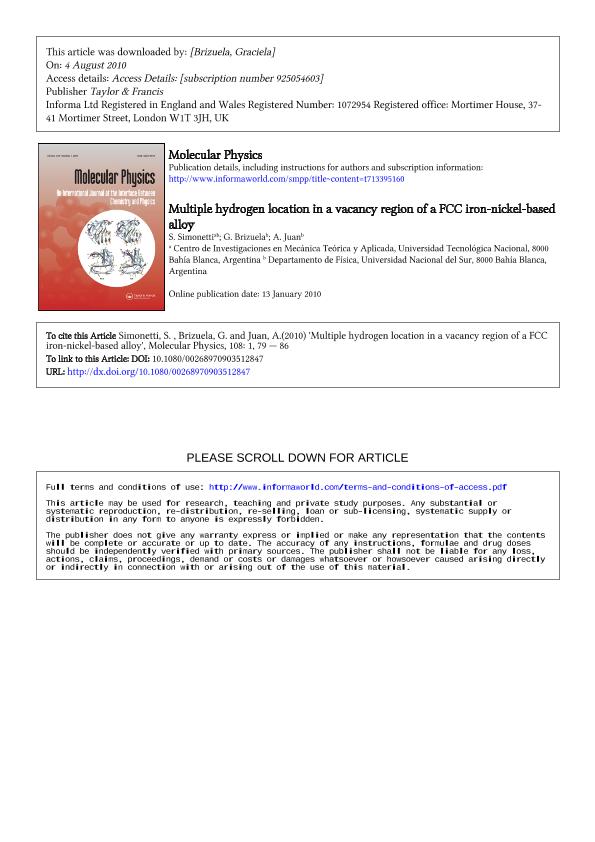Mostrar el registro sencillo del ítem
dc.contributor.author
Simonetti, Sandra Isabel

dc.contributor.author
Brizuela, Graciela Petra

dc.contributor.author
Juan, Alfredo

dc.date.available
2019-01-28T16:54:04Z
dc.date.issued
2010-10
dc.identifier.citation
Simonetti, Sandra Isabel; Brizuela, Graciela Petra; Juan, Alfredo; Multiple hydrogen location in a vacancy region of a FCC iron-nickel-based alloy; Taylor & Francis Ltd; Molecular Physics; 108; 1; 10-2010; 79-86
dc.identifier.issn
0026-8976
dc.identifier.uri
http://hdl.handle.net/11336/68722
dc.description.abstract
The interaction between four-hydrogen atoms and a FCC FeNi-based alloy ideal structure having a vacancy (V) was studied using a cluster model and a semi-empirical theoretical method. The energy of the system was calculated by the atom superposition and electron delocalisation molecular orbital (ASED-MO) method. The electronic structure was studied using the concept of density of states (DOS) and crystal orbital overlap population (COOP) curves. After a sequential absorption, the hydrogen atoms are finally positioned at their energy minima configurations, near to the vacancy. The energy difference for H agglomeration was also computed. The vacancy-Hn complexes become less stable for n > 3. The changes in the electronic structure of Fe and Ni atoms near to the vacancy were also analysed. The interactions mainly involve Fe and Ni, 4s and 4p atomic orbitals. The contribution of 3d orbitals is much less important. The Fe-Fe, Fe-Ni and Ni-Ni bonds are weakened as new Fe-H, Ni-H and H-H pairs are formed. The effect of the H atoms is limited to its first neighbours. The detrimental effect of H atoms on the metallic bonds can be related to the decohesion mechanism for H embrittlement.
dc.format
application/pdf
dc.language.iso
eng
dc.publisher
Taylor & Francis Ltd

dc.rights
info:eu-repo/semantics/openAccess
dc.rights.uri
https://creativecommons.org/licenses/by-nc-sa/2.5/ar/
dc.subject
Alloy
dc.subject
Computer Modelling And Simulation
dc.subject
Electronic Structure
dc.subject
Hydrogen
dc.subject
Vacancy
dc.subject.classification
Astronomía

dc.subject.classification
Ciencias Físicas

dc.subject.classification
CIENCIAS NATURALES Y EXACTAS

dc.title
Multiple hydrogen location in a vacancy region of a FCC iron-nickel-based alloy
dc.type
info:eu-repo/semantics/article
dc.type
info:ar-repo/semantics/artículo
dc.type
info:eu-repo/semantics/publishedVersion
dc.date.updated
2019-01-23T14:53:06Z
dc.journal.volume
108
dc.journal.number
1
dc.journal.pagination
79-86
dc.journal.pais
Reino Unido

dc.journal.ciudad
Londres
dc.description.fil
Fil: Simonetti, Sandra Isabel. Consejo Nacional de Investigaciones Científicas y Técnicas. Centro Científico Tecnológico Conicet - Bahía Blanca. Instituto de Física del Sur. Universidad Nacional del Sur. Departamento de Física. Instituto de Física del Sur; Argentina. Universidad Tecnológica Nacional,Centro de Investigaciones en Mecánica Teórica y Aplicada - Bahia Blanca; Argentina
dc.description.fil
Fil: Brizuela, Graciela Petra. Consejo Nacional de Investigaciones Científicas y Técnicas. Centro Científico Tecnológico Conicet - Bahía Blanca. Instituto de Física del Sur. Universidad Nacional del Sur. Departamento de Física. Instituto de Física del Sur; Argentina
dc.description.fil
Fil: Juan, Alfredo. Consejo Nacional de Investigaciones Científicas y Técnicas. Centro Científico Tecnológico Conicet - Bahía Blanca. Instituto de Física del Sur. Universidad Nacional del Sur. Departamento de Física. Instituto de Física del Sur; Argentina
dc.journal.title
Molecular Physics

dc.relation.alternativeid
info:eu-repo/semantics/altIdentifier/url/https://www.tandfonline.com/doi/abs/10.1080/00268970903512847
dc.relation.alternativeid
info:eu-repo/semantics/altIdentifier/doi/http://dx.doi.org/10.1080/00268970903512847
Archivos asociados
